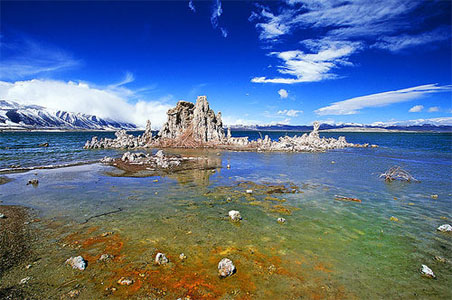NASA has recently announced the discovery of a bacteria in Mono Lake by Dr. Felise Wolfe-Simon which uses arsenic instead of phosphorous for its phosphorylation.
This may not sound all that impressive at first glance, but what Wolfe-Simon has discovered is a little critter which uses a substance inherently poisonous to every other form of life on the planet as one of its most elementary building blocks. It’s literally an entirely alternate path by which life could potentially evolve (and even thrive) in environments which would be completely hostile to (most) terrestial life. (I’m radically summarizing here. For a better summary, follow the link.)
As a scientific discovery, this is interesting in its own right. And its potential application in science fiction (from alien lifeforms to the utterly transhumanic) is pretty obvious.
But reading about this discovery also tickled my brain into thinking about the deeper substrates of fantasy. Here’s a quick quote from the link:
Phosphorus plays an important biological role in the form of ATP (Adenosine triphosphate), which is a cell’s “energy currency.” ATP is key to metabolic functions, and works by activating structural proteins & enzymes through donating its phosphorus groups.
On the Periodic Table, arsenic sits directly below phosphorus (meaning, among other things, they have the same number of valence electrons). In humans & other forms of life, arsenic can be deadly, since it disrupts cellular respiration by competing with phosphorus & diminishing ATP formation.An organism that uses arsenic in its biochemistry is “alien” to what is known, since it must have ATP-like molecules with arsenic swapped in phosphorus’ place and because they must have evolved mechanisms such that arsenic doesn’t kill them. All signs point to this announcement being tied to the work of biochemist Felisa Wolfe-Simon, who theorized in the past that the unusual ecosystem in California’s Mono Lake could have led some life to follow a different “evolutionary pathway.”
What other alien biochemistries could we imagine swapping into that process? Something alchemical? Something magical? Something celestial? Something other-planar? What pulses life through a migo’s cells or Cthulhu’s rubbery skin-substitute? What allows a dragon to process its food so efficiently?
This wouldn’t mean, of course, that dispel magic is going to automatically cause a dragon to cease to exist (any more than putting a plant in the shade will cause it to instantly wither). Such creatures might suffer from prolonged exposure to antimagic fields, but otherwise they’re probably fine. (Although we’d have to call into question fantasy’s prolixity for half-breeds.)
How could such life evolve? Well, it might arise naturally in a world permeated with magical energies. Or it might spawn from an artificial creation (perhaps even accidentally so). “Life will find a way” is hokey as science; but we’re not exactly dealing with science here: So when the animated rugs in the flying castle suddenly start mating with each other, we might not be quite as justified in our shock.
To a certain extent, of course, this has the danger of becoming “precious world-building”. (World-building that really has no meaningful impact on the game or narrative for which the world is ostensibly being designed.) How can we make this stuff actionable?
Stuff like Mitochondrial Eve from the Parasite Eve games suddenly begin to arise quite “naturally” out of injecting magical juju into your life cycle. Half-breeding could introduce a vector for infection and either explain ancient racist prejudices or justify fresh outbreaks of hate crimes and intolerance in your campaign world.
Literally incompatible biologies coming into conflict: The dark fey rising up out of the underdark aren’t just a threat to life and limb; their dark fairy circles are doing whatever the opposite of “terraforming” is. (Magiforming?) Cysts of alien, incompatible life spontaneously blooming in remote regions or incursions of malevolent extra-planar intelligences.
Why can’t we eat the monsters we’re killing? Because they’re fundamentally incompatible and indigestible. (“Don’t eat the demon-flesh, kid. It will fuck you up.”)
Did you know shadows weren’t originally undead in OD&D? They are something strange and other; something so utterly unnatural that our eyes can only perceive them as a living, tumescent absence.
All nature is a war. This kind of stuff just sort of firms up the lines of battle.













ARCHIVED HALOSCAN COMMENT
Leland Tankersley
I recall that not too long after this announcement there was a fair bit of noise about how the science behind the announcement was a bit dodgy. I only read summaries, and not closely at that, but I gather there is still a fair amount of doubt as to whether they actually found what they think they found.
Interesting if true, though.
Monday, January 03, 2011, 12:31:43 PM